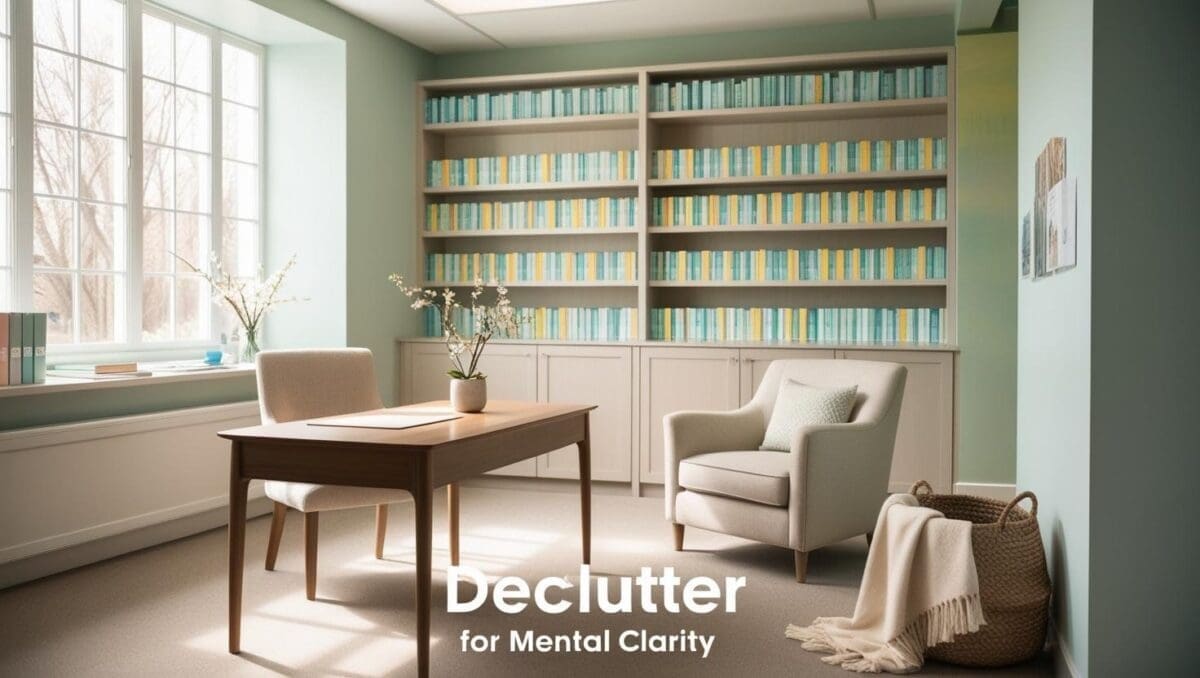Imagine a therapy space where stress visibly melts away, where every texture, sound, and beam of light quietly reassures your client: You are safe here.
Today, sensory room design isn’t just for schools or hospitals. More and more counselors are creating small sensory spaces in their private offices — places that support emotional regulation, reduce anxiety, and enhance the healing process.
In this comprehensive guide, you’ll learn how to select the right sensory tools, install them safely, integrate sensory experiences into sessions, and recreate a sensory-friendly environment without needing an entire renovation.
Whether you work with trauma survivors, neurodivergent clients, or anxious children, sensory environments can transform your practice — backed by research and real-world results.
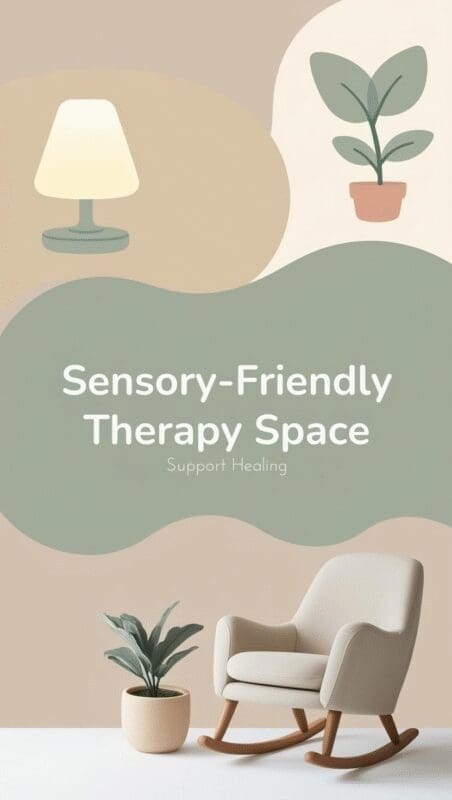
Affiliate Disclosure
Some links below are affiliate links, meaning that at no additional cost to you, I may earn a commission if you choose to make a purchase. I only recommend tools and resources I trust to support your counseling work.
Why Sensory Rooms Matter in Counseling (With Science)

Sensory rooms aren’t just trendy — they are backed by decades of research showing that controlled sensory input can regulate the nervous system, lower cortisol, and enhance therapeutic engagement.
According to The STAR Institute for Sensory Processing Disorder, calming sensory spaces help reduce fight-or-flight responses and allow clients to access higher-level thinking and emotional regulation (STAR Institute, 2022).
Trauma research, including the work of Dr. Bessel van der Kolk, also emphasizes that sensory integration supports healing from dysregulation caused by chronic stress and trauma.
“Safety is the foundation. If clients feel calm in their bodies, therapeutic work becomes possible.” — The Body Keeps the Score
Creating even a small sensory zone gives clients tools for self-regulation, improving outcomes across therapy modalities.
Reference Links:
Core Elements of Sensory Room Design for Counselors
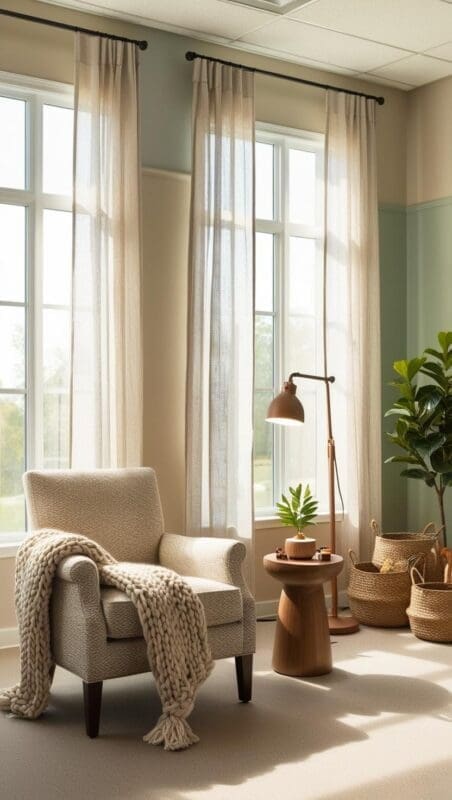
1. Soothing, Adjustable Lighting
Lighting impacts mood, attention, and nervous system activity. Studies show that warm-toned, adjustable lighting supports parasympathetic activation — the “rest and digest” system (Chellappa et al., 2019).
How to Recreate This:
- Use dimmable warm LED lamps (2700K) instead of overhead fluorescents.
- Add string fairy lights or fiber optic curtains for gentle visual stimulation.
- Blackout curtains + adjustable ambient lights let clients control brightness levels.
Tactile Comfort Zones: Using Touch to Support Regulation and Emotional Safety
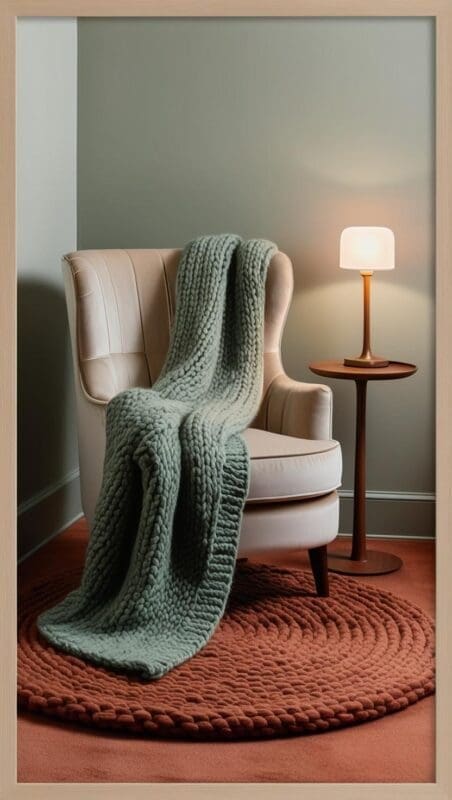
Grounding begins in the body.
Tactile input—especially deep pressure stimulation—has been shown to calm the autonomic nervous system, reduce cortisol levels, and promote feelings of safety (Field, 2010; Champagne, 2011). For clients who experience sensory dysregulation, anxiety, trauma, or neurodivergent processing, tactile comfort zones provide a powerful, non-verbal form of emotional support.
Incorporating textures into a sensory room isn’t just about making the space cozy. It’s a way to engage the proprioceptive and tactile systems—two of the body’s most regulating channels. These inputs help organize the brain and body, promoting better emotional regulation, focus, and a sense of containment.
Why It Works:
- Deep pressure stimulation (DPS)—such as weighted blankets or firm cushions—activates the parasympathetic nervous system, slowing the heart rate and reducing arousal (Grandin, 1992; Field, 2010).
- Tactile variety can gently stimulate clients out of dissociation or hypoarousal states, especially in trauma recovery work.
- Textural input also helps neurodivergent clients (e.g., those with autism or ADHD) self-soothe or anchor attention in the moment (Baranek, 2002).
How to Recreate Tactile Comfort Zones in a Therapy Room:
✔ Weighted Lap Pads or Plush Throws
Add these to your seating areas or regulation corners. Lap pads during seated sessions offer subtle grounding without distraction. Use washable, neutral-toned fabric for comfort and hygiene.
✔ DIY Tactile Wall Panels
Install felt, faux fur, cork tiles, or ridged wood panels at reachable heights—especially helpful in child therapy rooms or for clients with sensory-seeking tendencies. These can be used intentionally during breaks or regulation moments.
✔ Layered Textures in Grounded Spaces
Use:
- Woven, knotted, or shag rugs for underfoot tactile support
- Bean bags, poufs, or floor cushions that encourage relaxed posture and soft body contact
- Velvet, knit, or boucle pillows in muted tones to invite interaction without overstimulation
✔ Tactile Bins or “Comfort Corners”
In a small basket, keep touch-based grounding tools (e.g., soft cloths, sand-filled shapes, or sensory stones). Offer them as a form of mindful regulation during transitions or post-processing.
🧠 Counselor Tip: Tactile tools are most effective when introduced through modeling or co-regulation. Normalize their use and observe what clients gravitate toward—they’ll tell you what their nervous system needs.
3. Gentle Soundscapes
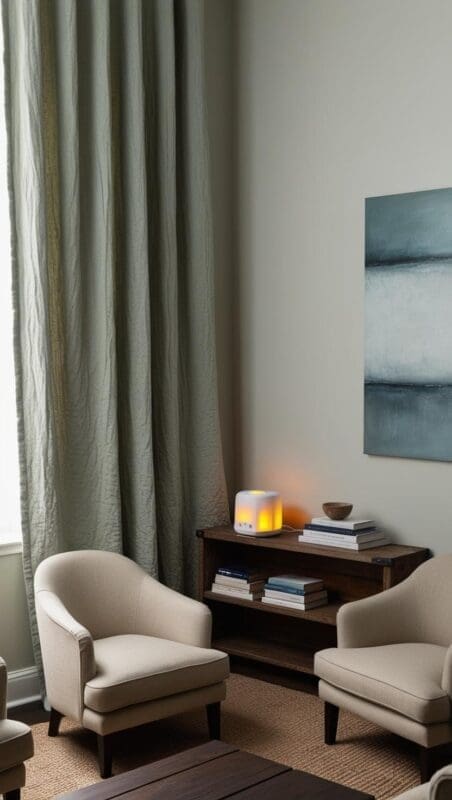
Sound can either soothe or trigger. Research in environmental psychology shows that sound masking (white noise, nature sounds) reduces cortisol and improves focus (Veitch & Newsham, 2000).
How to Recreate This:
- Set up a white noise machine with adjustable volume.
- Offer optional calming playlists (ocean sounds, forest rain) through a Bluetooth speaker.
- Hang fabric wall panels or use thick curtains to buffer external noise.
✨ New Free Tool for Counselors & Therapists
Want to send your clients a gentle reminder for their next session — with a dose of encouragement and warmth? Try this beautifully designed, free printable Session Reminder Card Generator — created especially for therapists, counselors, and social workers.
No sign-up required. Just personalize, download, and print or send.
4. Movement Opportunities: Micro-Movements That Support Regulation and Connection
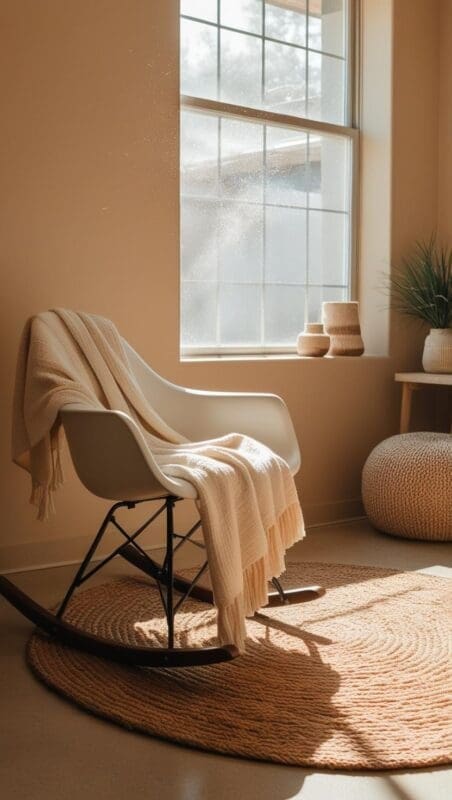
Motion regulates emotion.
According to sensory integration theory (Ayres, 1979), movement plays a critical role in modulating arousal, supporting focus, and integrating sensory input. The vestibular system (which helps with balance and spatial orientation) and the proprioceptive system (which informs body awareness) are directly influenced by physical motion—especially repetitive, rhythmic, or resistive movements.
For clients experiencing hyperarousal (e.g., anxiety, trauma triggers) or hypoarousal (e.g., dissociation, shutdown), providing subtle movement opportunities can help them reconnect to their body, reduce agitation, and feel safe enough to engage in therapeutic work.
Why It Works:
- Vestibular stimulation (like gentle rocking or shifting) helps modulate fight-or-flight responses by regulating the inner ear’s impact on brain arousal centers (Schaaf & Mailloux, 2015).
- Proprioceptive input (e.g., pushing, stretching, or pressure) grounds the body in space and enhances regulation by giving the nervous system concrete sensory data.
- Movement also supports executive functioning, working memory, and emotional regulation—especially in children, neurodivergent clients, or anyone dealing with sensory processing challenges.
How to Incorporate Micro-Movement Tools in a Therapy Room:
✔ Rocking Chairs or Glider Chairs
Place a rocking chair or glider in a cozy corner. The rhythmic motion is especially soothing for trauma-impacted clients or children in sensory overload. Therapists can also use it during co-regulation.
✔ Balance Cushions or Wobble Seats
These are great on top of a regular chair. They activate core stability while providing just enough motion to support attention and body awareness—ideal for ADHD or anxious clients.
✔ Under-Desk Foot Swings or Floor Pedals
Install quiet foot fidgets under a desk or table for clients who benefit from discreet movement while talking. These options are excellent for telehealth-friendly offices or for clients who mask or internalize discomfort.
✔ Mini Therapy Balls or Resistance Bands
Have a small therapy ball or resistance band nearby that clients can squeeze, roll under their feet, or stretch subtly. These tools give proprioceptive input without drawing too much attention.
✔ Movement Breaks for Child & Adolescent Clients
For younger clients, incorporate scheduled movement breaks or set up a “wiggle corner” with:
- A balance beam mat
- A mini trampoline
- A body sock or crash pad
This supports emotional reset and sensory regulation between activities or after intense emotional processing.
🧠 Counselor Tip: Offer movement tools as an opt-in resource, not a requirement. Clients often regulate better when they have choice and agency in how they use their body to feel safe.
Olfactory Calm: How Scent Supports Emotional Regulation in Therapy
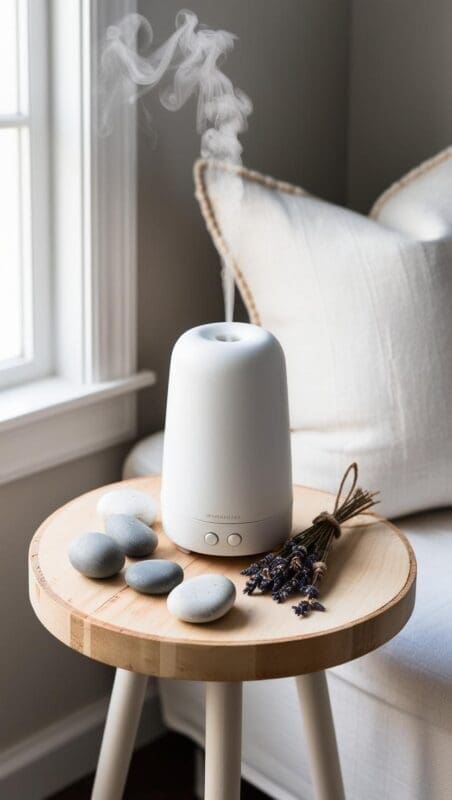
Scent is the fastest path to memory and mood.
The olfactory system is the only sensory pathway that connects directly to the limbic system—the part of the brain responsible for emotional processing, memory, and the stress response. This is why certain smells can instantly evoke calm, comfort, or even intense memories (Herz, 2009). In a sensory-informed therapy room, intentional use of calming scents can support relaxation and help clients feel emotionally anchored.
But scent is also personal. For one client, lavender may soothe; for another, it may trigger discomfort or trauma associations. That’s why it’s essential to approach olfactory input with consent, collaboration, and flexibility.
Why It Works:
- Lavender, cedarwood, and bergamot have been shown to reduce heart rate and support parasympathetic nervous system activation (Heuberger et al., 2001; Herz, 2009).
- Pleasant, low-level scents can enhance mood and facilitate emotional safety in therapeutic environments (Diego et al., 1998).
- Scent-based rituals (e.g., choosing a calming oil) can empower clients to participate in self-regulation strategies.
How to Ethically and Effectively Incorporate Scent in Therapy Rooms:
✔ Use Only With Informed Client Consent
Before introducing any scent into the space, ask the client directly:
- “Are you open to trying a calming scent in session?”
- “Do you have any scents that help you feel safe, grounded, or calm?”
If they decline, always respect that preference and provide a scent-free environment.
✔ Create a Personalized Scent Menu
Offer 2–4 options (e.g., lavender, vanilla, bergamot, cedarwood) in small vials or scent strips. Let clients:
- Smell each sample and discuss how it makes them feel
- Choose one to use during session, if they wish
- Bring their own comfort scent (e.g., essential oil, sachet, or lotion)
✔ Diffuse or Contain Scents Thoughtfully
Use a water-based diffuser, reed diffuser, or an aromatherapy inhaler. Keep the scent subtle and localized—never overpowering the space.
✔ Reset the Space Between Clients
To avoid overstimulating or triggering other clients:
- Use unscented cleaning wipes or diffusers to clear the air
- Open windows briefly or run an air purifier between sessions
- Avoid any residual scent that lingers into the next appointment
✔ Discuss Scent as a Regulation Tool
Talk with clients about how certain smells affect their body and mood:
- “Do you ever use scent to help you relax at home?”
- “What does calm smell like to you?”
This opens up a creative, embodied dialogue about grounding strategies clients can carry beyond session.
🧠 Counselor Tip: Scent can serve as a transitional ritual—marking the start of session, helping clients reorient after emotional processing, or preparing to return to daily life.
How to Build a Sensory-Friendly Zone (Even Without a Full Room)
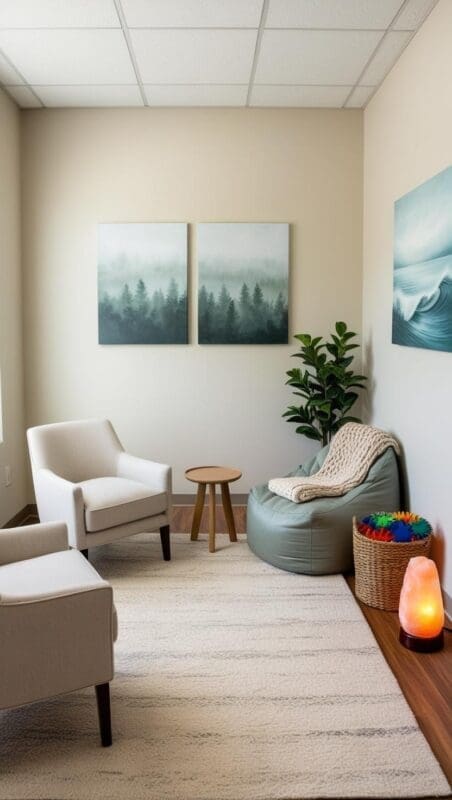
You don’t need a dedicated room—just an intentional corner.
While full sensory rooms can be powerful, many counselors and school-based therapists don’t have the luxury of a second space. The good news? Even a small, well-designed sensory-friendly corner can offer meaningful regulation, grounding, and emotional safety.
Think of this zone as a “micro-environment”—a designated area that communicates: this is a space where your nervous system can slow down and your body can exhale.
🪑 Mini Sensory Zone Setup (Fits in One Corner):
✔ One Comfortable Chair
Preferably with soft arms or a curved back to enhance a feeling of containment. Add a weighted blanket or lap pad for proprioceptive input.
✔ Soft, Adjustable Lighting
A cordless lamp or warm-tone LED light keeps the space cozy and calm. Avoid overhead fluorescent lighting near this zone.
✔ Essential Oil Diffuser or Inhaler (Optional & With Consent)
Pair with calming scents (lavender, vanilla, or cedar) chosen collaboratively with the client. Keep it subtle, not ambient, and always scent-clear the space after use.
✔ Noise Machine or Sound Options
White noise, gentle nature sounds, or brown noise can help buffer outside distractions and create an internal cocoon for clients.
✔ Tactile Sensory Box
Fill a small basket with regulation tools:
- Fidget stones or kinetic sand
- Soft textured swatches (velvet, fleece, corduroy)
- Grounding tools like worry dolls, sensory bracelets, or mini stress balls
✔ Visual Calming Tools
Include quiet, mesmerizing visuals that invite mindful attention:
- Sand timers
- Liquid motion bubblers
- Glow jar or dim fiber-optic lights
📍 Placement Tips:
- Choose a corner away from doors or windows to reduce sensory input and enhance safety.
- Face the seating toward a neutral wall, not directly at shelves or high-traffic zones.
- Keep the area clearly defined with a rug or soft divider if space allows—this helps communicate “this is your calm zone.”
🧠 Counselor Insight: Even in small offices, this setup can signal emotional permission for clients to co-regulate, decompress, or pause during intense moments. It’s especially helpful for trauma-informed work, youth sessions, or clients with sensory sensitivities.
How Sensory Tools Support Mental Health Outcomes
Implementing sensory strategies in therapy offices is shown to:
- Lower cortisol and reduce chronic stress response【STAR Institute】
- Improve emotional regulation for trauma, ADHD, and anxiety【The Body Keeps the Score】
- Increase therapeutic engagement and reduce session dropouts【Journal of Environmental Psychology】
Even simple tools like cozy lighting or tactile fidgets empower clients to reconnect with their bodies — a crucial foundation for deeper therapeutic work.
Common Mistakes to Avoid
- Overstimulating the senses (too much light/sound at once)
- Ignoring client choice (sensory experiences must feel empowering)
- Neglecting trauma sensitivity (clients must have easy exits and control options)
Always aim for “calm, not crowded.” Less is often more.
Main Takeaways
- Start small: A sensory corner can be just as powerful as a full room.
- Think multisensory: Light, touch, sound, movement, and smell work together.
- Empower clients: Offer sensory choices, not prescriptions.
- Use science: Design choices that support real nervous system regulation.
- Invest smartly: Begin with versatile basics and expand as needed.
Final Thoughts: Every Therapy Space Can Become Sensory-Aware
Creating a sensory-friendly therapy room isn’t about having a large space or expensive tools—it’s about being intentional. Whether you’re designing a full sensory room or carving out a calming corner, small, sensory-informed changes can lead to big shifts in how your clients feel, regulate, and connect.
As counselors, we hold space with our words—but also with our environment. By integrating elements that soothe the senses—touch, sound, scent, light, and movement—we invite our clients to come home to themselves, one layer at a time.
🌿 Healing begins with safety. Sensory design helps make safety tangible.
Looking to Create a Calming Environment for Your Clients?
Continue building your therapeutic space with these reader favorites:
- Designing and Decorating a Modern Style Therapy Office
Learn how to blend professionalism with calm, minimalist beauty. - Budget-Friendly Minimalist Therapy Office
Get ideas for a sleek, sensory-informed space—without breaking the bank. - The Best Accent Armchairs for Your Therapy Office
Discover therapist-approved seating that balances comfort and containment. - Incorporating Cordless Lamps in Your Therapy Office
A lighting guide for small offices where calm ambiance matters most. - Spring Decor Ideas for Therapists
Refresh your therapy space seasonally with light, texture, and warmth.
💬 What’s in Your Sensory Space?
Whether you’ve designed a full sensory room or just added one tactile tool, I’d love to hear how sensory elements have changed the feel of your therapy space. Leave a comment or share your favorite regulation strategies with fellow counselors—we’re always learning together.

About the Author
Hi, I’m Eve, a former school counselor with a master’s degree in School Psychology and a passionate advocate for children and families navigating sensory challenges. As a mom of children with sensory sensitivities, I deeply understand the journey special-needs parents face, and I dedicate myself to researching and sharing practical solutions to help children thrive and feel comfortable in their bodies. My goal is also to empower counselors, therapists, and psychologists with creative strategies and supportive resources to enrich their everyday practice. When I’m not writing or exploring new therapeutic approaches, you’ll find me spending quality time with my family and continually seeking inspiration from everyday moments.

